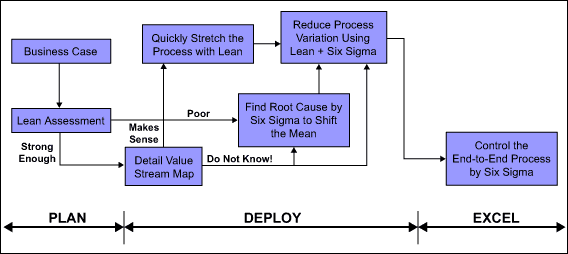
Information technology (IT) organizations increasingly are under pressure to improve their service and process capability. In the quest for improvement methodologies, organizations often adopt a “pick one” strategy – with Six Sigma being the widely favored choice. However, it is possible to integrate Lean and Six Sigma and reap the full benefits that these methodologies can bring to the table. Although Lean may appear to have limited applications beyond the production floor, it can offer many possibilities when it comes to total value stream integration.
Software Process Improvement – the Lean Way
Six Sigma and Lean can work together and complement each other. The key is to understand what part of the process to be improved is affected by variation and what part is affected by waste. Variation often manifests itself as defects, which is what Six Sigma aims to reduce. Process wastes are often hard to see and that is where Lean helps.
One of the first steps in Lean thinking is to understand what “value” is, and what activities and resources are absolutely necessary to create value. In the software world, this often creates confusion as to how to apply the principles of Lean. The project management white paper, “Lean Software Development” by Dasari. Ravi Kumar explains how typical Lean wastes relate to the software world (see table below).
| Lean Wastes Related to Software | |
| Seven Lean Wastes | Seven Wastes of Software Development |
| Overproduction | Extra features, functions |
| Inventory | Requirements |
| Extra processing steps | Extra steps, extra reviews |
| Motion | Finding information |
| Defects | Bugs not caught in testing |
| Waiting | Delays due to decisions |
| Transportation | Handoffs |
A good starting point is to do a Lean assessment to look for areas of improvement and to uncover value traps that are bogging down the process. Once a process is “Leaned out,” then it can be examined for quality problems under the lens of Six Sigma, and practitioners can try to figure out what causes variation. Most business processes can benefit from application of Lean principles. The difficulty often lies in identifying which defective process will yield the biggest bang for the buck.

Three key observations can be drawn from the figure above, which depicts a framework for the integration of Lean and Six Sigma:
Observation 1: On the left side of the framework Lean is leveraged to trigger improvement opportunities. This is because Lean often addresses problems that are very visible (too much inventory, excessive motion, etc.) and data is not always important. Through this, “quick strike” Lean opportunities are identified along with detailed diagnosis of other processes for value capture. At this stage, the scope and complexity of the process improvement are minimal.
Observation 2: Scope and complexity start increasing as one moves from left to right in the process framework. This is the start of deep core drilling into the hidden cost of poor quality with the combined synergy of Lean and Six Sigma. Making a dent in these areas often results in cost reductions of 2 to 7 percent of annual revenues for successful organizations.
Observation 3: Lean and Six Sigma are synergistic but require a structured recipe for success. If the tools are leveraged in a coordinated manner, this can bring in benefit where the whole is often more than the sum of the parts. Whether the recipe is fundamentally Lean with only minor application of Six Sigma, or the opposite, depends on the organization’s ability to absorb and assimilate change.
Conclusion: Different Issues, Different Methodologies
The truth is that not every issue calls for the same set of methodologies and tools. One size does not fit all. If a company limits itself to using Six Sigma for every issue, it will be equivalent to using a hammer and nail where all that was needed was a push pin. The key is to analyze and characterize every issue thoroughly. While some could be quick hit issues that Kaizen events can address, others could be related to waste, flow and flexibility where Lean can help. Other issues may be related to complex variation that can be reduced using Six Sigma. Finally, there may be issues related to fundamentally good processes that need the customer/supplier redundancies removed using IT optimization techniques.